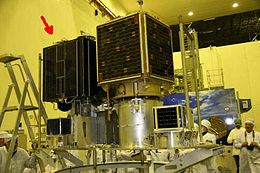 EgyptSat 1 (left) and Saudi Sat 3 (right) | |
| Mission type | Remote sensing |
|---|---|
| Operator | NARSS |
| COSPAR ID | 2007-012A[1] |
| SATCAT no. | 31117[1] |
| Website | www |
| Mission duration | Planned: 5 years; Achieved: 3 years, 3 months, 2 days |
| Spacecraft properties | |
| Bus | MS-1TK[2] |
| Manufacturer | Yuzhnoye Design Bureau |
| Launch mass | 165 kilograms (364 lb)[3][4] |
| Power | 65 watts[5] |
| Start of mission | |
| Launch date | April 17, 2007, 07:02 UTC |
| Rocket | Dnepr |
| Launch site | Baikonur 109/95 |
| Contractor | ISC Kosmotras |
| End of mission | |
| Last contact | July 19, 2010[6] |
| Orbital parameters | |
| Reference system | Geocentric |
| Regime | Sun-Synchronous |
| Perigee altitude | 658 kilometres (409 mi)[7] |
| Apogee altitude | 666 kilometres (414 mi)[7] |
| Inclination | 98.1 degrees[7] |
| Main Push broom scanner[4] | |
| Name | EgyptSat 1 |
| Resolution | 7.8 metres (26 ft) (MBEI)[4] 39 metres (128 ft) (cross-track) x 46 metres (151 ft) (along-track) (IREI)[4] |
EgyptSat | |
EgyptSat 1 or MisrSat-1 was Egypt's first Earth remote sensing satellite. This satellite was jointly built by Egypt's National Authority for Remote Sensing and Space Sciences together with the Yuzhnoye Design Bureau in Ukraine and was launched on board a Dnepr rocket on 17 April 2007 from the Baikonur Cosmodrome.
The effort was spearheaded by Dr. Aly Sadek, chairman of the Egyptian Council for Space Science and Technology Research. It in many ways was considered a huge step for the Egyptians since it marked the first time they opted for technology transfer during the manufacturing the satellite rather than simply purchasing one (as in case of the Nilesat satellites). On 23 October 2010, the National Authority for Remote Sensing and Space Sciences announced that control and communication with the satellite had been lost since July 2010.[8][9][10]
- ^ a b "EgyptSat 1". National Space Science Data Center Administration - National Aeronautics and Space Administration. Archived from the original on 29 March 2016. Retrieved 23 August 2013.
- ^ "EgyptSat-1". russianspaceweb.com. Archived from the original on 18 June 2014. Retrieved 1 September 2014.
- ^ Abd Al-Rahman, Zahraa. "Assessment Of Egyptian Satellite (EGYPT SAT-1) Images For The Production and Updating Of 1:25000 Planimetric Maps" (PDF). Association of American Geographers. Archived from the original (PDF) on 2 December 2012. Retrieved 23 August 2013.
- ^ a b c d Kramer, Herbert J. "EgyptSat-1". eoPortal Directory. Archived from the original on 21 October 2013. Retrieved 23 August 2013.
- ^ "Hartron-Arkos, Control systems for space and ground applications". Archived from the original on 2012-03-08. Retrieved 2013-08-19.
- ^ "Archived copy" (PDF). Archived from the original (PDF) on 2014-04-13. Retrieved 2013-08-19.
{{cite web}}: CS1 maint: archived copy as title (link) - ^ a b c "EgyptSat 1". National Space Science Data Center Administration (Goddard Space Flight Center). National Aeronautics and Space Administration. Archived from the original on 29 March 2016. Retrieved 23 August 2013.
- ^ "اختفاء القمر الصناعي المصري «إيجبت سات 1» | المصري اليوم، أخبار اليوم من مصر". Archived from the original on 2010-10-25. Retrieved 2010-10-25.
- ^ "خبير: القمر مصر سات انتهى عمره الافتراضي بعد نصف المدة.. وفرصة استعادته ضعيفة". Archived from the original on 2010-10-28. Retrieved 2010-10-25.
- ^ "هيئة الاستشعار: فقدنا الاتصال والسيطرة على القمر البحثي ايجبت سات1". Archived from the original on 2010-10-26. Retrieved 2010-10-25.